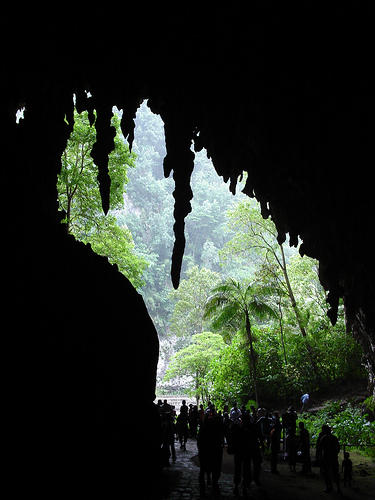

Location: 12 km from Caripe, Monagas state Map
Area: 627 km²
Tel. 0292 641 7543
Entrance Fee: $6, kids $3
Open: 8am- 4pm
Cueva del Guácharo National Park is located 12 km
from aripe in Monagas state of Northwest Venezuela. This national
park covers an area of 627 km² and protects the delicate ecosystem
of Guácharo Cave that also gives the name to this nature reserve.
Guácharo Cave is largest natural underground system that measures a
total of 10.2 km (6.3 miles) in length. One of the first visitor of
the cave was famous German (Prussian) biologist Alexander von
Humboldt. Cueva del Guachara gets its name from guacharo birds or
oilbird that live inside. This nocturnal bird lives in the cave
system by day and leaves it to hunt by night. It has a radar
location system similar to bats to navigate underground as well as
night rain forests. You can camp out at the entrance to the cave and
watch these beautiful rare birds leave the cave around 6pm and come
back early in the morning around 4 am.
You can get here by
bus or by getting a car from Caripe or Cumana, closest large
settlement close to the cave entrance. Try to keep your voice down
then you enter the cave. Many of its local inhabitants like oil
birds and bats might be scarred by loud sudden noises. The
temperature inside the cave usually remains at the comfortable 19 °C
with humidity up to 100%. Although the whole underground system
measures over 10 km in length only small fraction of this is open to
the public.
History
The Guácharo Cave was visited by Alexander
von Humboldt on September 18, 1799 by the German naturalist, although
previously it was constantly visited by indigenous people of the Chaima
Ethnic Group, the Guácharo cave was important for this ethnic group and
represents an important part of their beliefs, and where the piaches
also carried out their rituals; "shamans" of the ethnic group, is
located 4 km from the closest town, which is Caripe del Guácharo, north
of Monagas State, right in the Cerro Negro sector of the Caripe massif.
It is located at an altitude of 1065 m, with an average annual
temperature of around 21°C, it is considered to be approximately 10.5 km
long. It is carved out of sedimentary rocks that were formed 130 million
years ago in the Mesozoic era in an ancient sea. The sea withdraws as a
result of the lifting of the earth's crust, giving rise to the Eastern
Massif. Water erosion produces leaks that originate a whole network of
branches and interconnected galleries. Throughout the cave there are
many galleries or rooms, among which are: the Great Hall of Landslide,
the Hall of Alén, the Precious Hall, the Hall of Silence, the Hall of
Giants, among others.
The total extension of the cave is not
known exactly, which constitutes a great mystery and gives rise to many
myths.
Fauna
One of the outstanding characteristics of this
monument is that it serves as a habitat for the guácharo (Steatornis
caripensis), a bird with nocturnal habits adapted to live in the dark,
which only leave the cave at twilight and at night when they go out in
search of food. Some bats, insects, rodents, arachnids and beetles also
coexist in this ecosystem.
The Guacharo
The Steatornis
caripensis or guácharo is a frugivorous bird that inhabits the first
gallery of the cave, it comes out at night in search of food. Its name
is onomatopoeic, it is derived from the Quechua waqay (scream or cry),
due to its characteristic song. Its color is brown with black and white
spots, a long tail, and bristles around the beak. It measures about 19
inches long, and they have about a 36-inch wingspan. The guácharo
produces in the cave an organic layer called guano, formed by vomited
seeds and excrement that constitutes the basic nutrient of the cave
ecosystem. The most important daily event in the park occurs in the
afternoon when the birds leave the cave in large flocks to look for
food. This same species gives its name to another natural park: The
Cueva de los Guácharos National Natural Park on the western slope of the
Cordillera Oriental, in Venezuela. A large amount of food for these
birds is found in the remote environment of the cave and in other
places; The Mata de Mango area is particularly important, in the Caripe
River Middle Basin sector. In the nocturnal flight, the guácharos travel
up to 120 km away to search for fruits and fatty seeds, especially in
the non-breeding season, while in the breeding season they search for
food within a radius of about 40 km. So the guácharo leaves the cave
daily in search of food; it does so by flocks of thousands of
individuals. It then returns to digest and feed the chicks.
Approximately 10,000 specimens are estimated inside the cave.
Other typical animals of the place
There is a wide variety of
birdlife within the Park, consisting of approximately 370 species of
birds, among which are; chivi cabecigris, Fafao gargantiblanco, Pica
Flores Negro, Pico de Frasco Esmeralda, among others. There is also a
variety of mammals, such as the Araguato monkey, the puma, the cinchated
peccary, the tapir, the caramerudo deer, among others.
Flora
The mountainous landscape, with rugged relief, given by a very dense
hydrography that results in narrow valleys limited by strongly inclined
slopes. There is a very common tree, the copey and Clusia alata. Among
others are the Laurel, the guayabito, the paneco and the platanillo.
Associated with these trees are tree ferns and a large number of
epiphytes and climbers. Orchids or the so-called flower of May abound;
recognized as the National Flower of Venezuela.